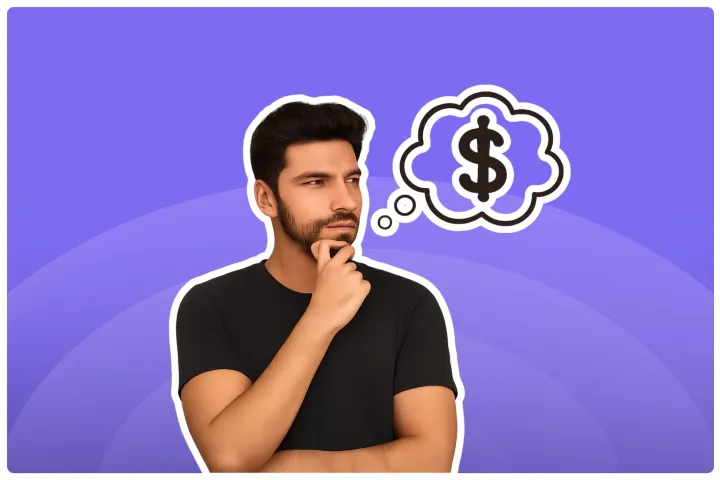Top 5 Influencer App For Brand Collaboration (2025)
Discover the 5 best influencer apps to collaborate with brands. Boost your marketing strategy and connect with top creators!
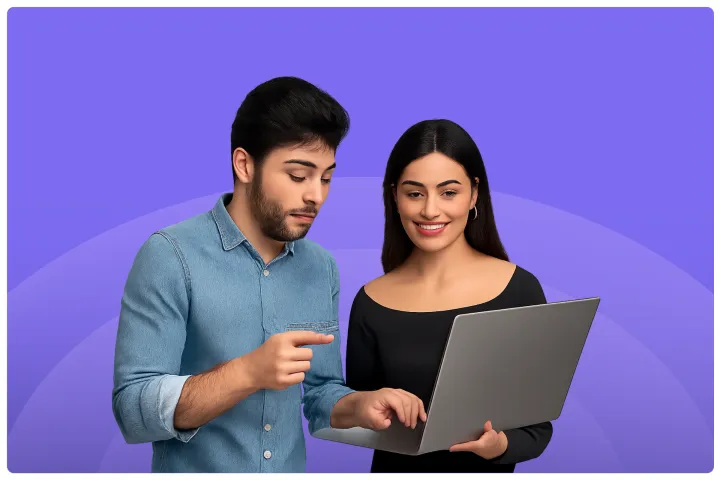
The influencer marketing scene in India is booming! A Qoruz report highlighted that from just 962,000 influencers in 2020, India saw a staggering 322% growth to 4.06 million influencers in 2024. That's a massive pool of talent! And brands are taking notice, with over ₹5500 crore invested in influencer marketing in India in 2024 alone (Source: Qoruz, as reported by Textile Insights). This isn't just a trend; it's a fundamental shift in how brands are connecting with people.
You might be thinking, "With so many influencers, how do I find the right ones? How do I manage campaigns without pulling my hair out? And how do I know if it's actually working?" That's where influencer apps come in, my friend. They are designed to streamline the entire process, from finding your perfect influencer match to tracking your campaign's success.
Think of these apps as your super-smart, ultra-organized assistants for influencer marketing. They help you cut through the noise, make data-driven decisions, and ultimately, get a better return on your investment. Globally, for every $1 spent on influencer marketing, brands can earn up to $5.78 in return (Source: Business2Community). That's some serious ROI!
So, get ready to level up your brand collaboration game. We're about to look at what makes a great influencer app and then check out the top 10 contenders for 2025 that can help you make a real impact. Let's go! 🚀
Criteria for Evaluating Influencer Apps
Choosing the right influencer app can feel like a big decision, but don't worry, I've got your back! When you're looking at different platforms, there are a few key things that can make a huge difference to your campaigns. Let's break them down so you know exactly what to look for.
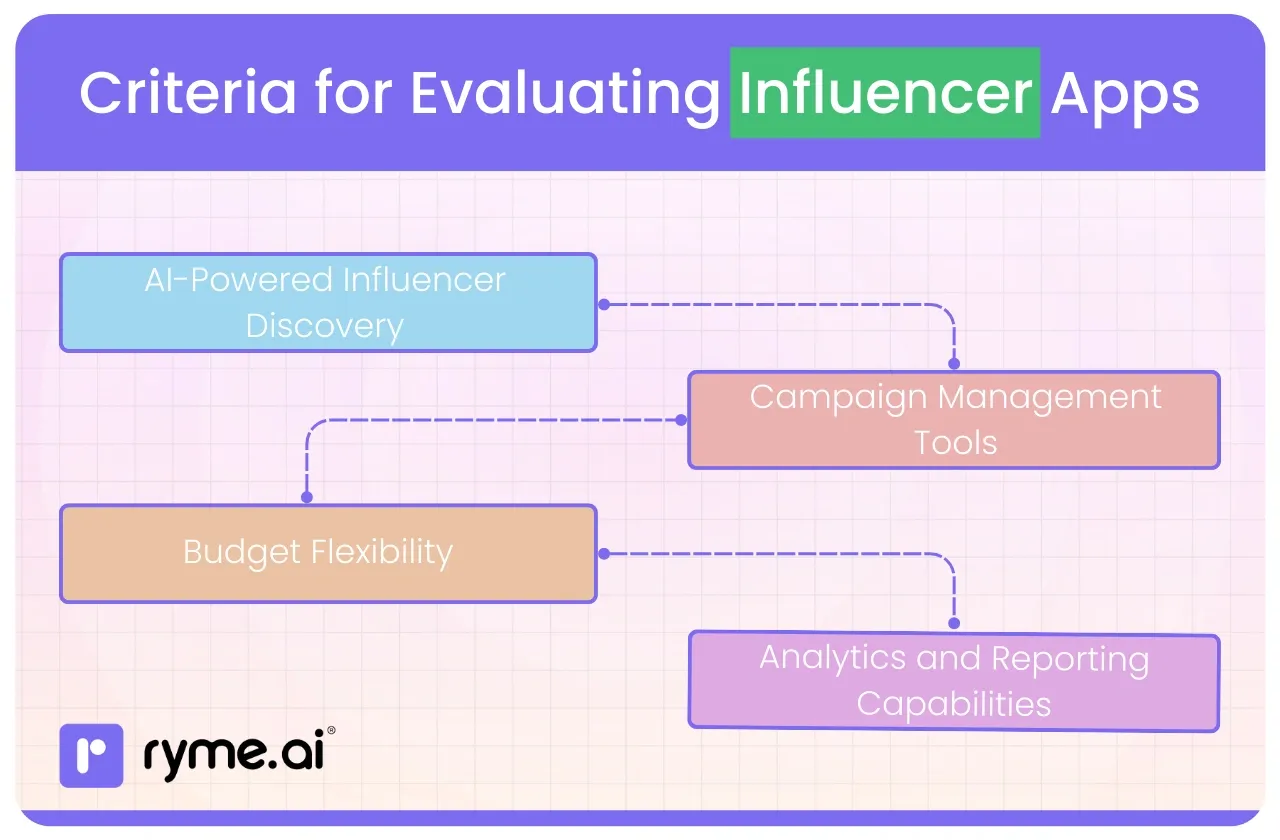
1) AI-Powered Influencer Discovery
What it is: This is all about using the power of artificial intelligence (AI) to find influencers who are the perfect fit for your brand. Instead of spending hours scrolling through social media or relying on guesswork, AI algorithms analyze massive amounts of data. They look at an influencer's content, audience demographics, engagement rates, past collaborations, and even the sentiment of their followers' comments.
Why it matters for you:
a) Precision Matching: AI doesn't just find popular influencers; it finds relevant ones. This means their audience is more likely to be interested in your products or services. Imagine you're a sustainable fashion brand. AI can help you find influencers who genuinely care about ethical fashion and have an audience that shares those values.
This leads to more authentic endorsements and better campaign results. According to Influencer Marketing Hub, 63% of brands were planning to use AI for influencer identification in 2024, showing a clear trend towards smarter discovery.
b) Saves Time (and Sanity!): Manually searching for influencers is incredibly time-consuming. AI tools can do this heavy lifting in minutes, freeing you up to focus on strategy and building relationships.
c) Uncover Hidden Gems: AI can help you find micro-influencers or rising stars who have a highly engaged, niche audience but might not be on everyone's radar yet. These influencers often have higher engagement rates and can be more cost-effective. HubSpot found that 64% of marketers have worked with micro-influencers, with 47% reporting them as their most successful partners.
d) Audience Authenticity: A big concern for brands is influencer fraud (fake followers, inflated engagement). Advanced AI can analyze an influencer's audience for suspicious patterns, helping you avoid partnerships that won't deliver real value. This is crucial as 59.8% of brands experienced fraud in 2023 (Source: Influencer Marketing Hub).
What a good AI discovery tool looks like:
It should allow you to search using very specific criteria, not just keywords. For example:
"Female lifestyle influencers in Mumbai, aged 25-35, with an audience interested in vegan cooking and an engagement rate above 3%."
It should provide detailed analytics on each influencer, including audience demographics (age, location, interests), true engagement rates, and potential red flags.
Some platforms even use AI to predict how well an influencer might perform for your specific brand or campaign.
Think of AI-powered discovery as your super-smart talent scout, working tirelessly to bring you the best matches.
2) Campaign Management Tools
What it is: Once you've found your influencers, you need a way to manage the collaboration smoothly. Campaign management tools are the features within an influencer app that help you organize everything from start to finish. This includes communication, briefing, content approvals, payment processing, and tracking deliverables.
Why it matters for you:
a) Streamlined Collaboration: Juggling emails, DMs, spreadsheets, and different versions of content can quickly become chaotic, especially if you're working with multiple influencers. A good platform keeps everything in one place.
b) Clear Communication: Centralized messaging ensures everyone is on the same page. You can send
briefs, answer questions, and provide feedback directly within the app. No more lost emails!
c) Efficient Content Approval Workflows: This is a big one. You need to review and approve content before it goes live. Platforms with built-in approval workflows allow influencers to submit content, and you can provide feedback or approve it with a click. Some tools even allow for version control. This avoids back-and-forth emails and speeds up the process, preventing those dreaded content approval delays.
d) Performance Tracking (at a glance): While detailed analytics are covered next, campaign management tools often give you a quick overview of how things are progressing. Are posts going live on time? What's the initial engagement like?
e) Organized Deliverables: Keep track of which influencer is responsible for what, deadlines, and whether they’ve completed their tasks.
f) Simplified Payments: Some platforms integrate payment processing, making it easier to pay your influencers securely and on time. This can be a huge admin relief.
What good campaign management tools look like:
Imagine a dashboard where you can see all your active campaigns. For each campaign:
- A list of participating influencers.
- The status of their content (e.g., "Brief Sent," "Content Submitted," "Approved," "Published").
- A calendar view of when content is scheduled to go live.
- A dedicated space for communication and file sharing with each influencer.
- Automated reminders for deadlines.
For example, let's say you're launching a new line of skincare products. You've partnered with five beauty influencers. A good campaign management tool would let you:
- Send a detailed brief to all five influencers simultaneously, outlining the key messages, do's and don'ts, and content formats (e.g., 1 Instagram post, 2 Stories).
- Have each influencer submit their draft posts and Stories directly through the platform.
- You and your team can then review the content. Perhaps for Influencer A's post, you want a slight change in the caption. You can leave a comment directly on their submission.
- Once approved, you can see when each piece of content is scheduled and confirm when it goes live.
Without these tools, you'd be managing this via five separate email threads, trying to keep track of different versions of Word documents for captions, and manually checking their profiles. Sounds exhausting, right? Campaign management tools bring order to the chaos!
3) Budget Flexibility
What it is: This means the platform can cater to your financial needs, whether you're a startup bootstrapping your first campaign or a large company with a significant marketing spend. It’s about finding a solution that offers value for money at your scale.
Why it matters for you:
a) Accessibility for All: Not every brand has a massive budget for influencer marketing, especially when starting out. Platforms that offer flexible pricing models, low or no minimum budget requirements, or even free tiers for basic features can be a lifesaver for small to medium-sized businesses (SMBs) and Direct-to-Consumer (D2C) brands.
b) Scalability: As your business grows and your influencer marketing efforts become more sophisticated, you need a platform that can grow with you. This might mean access to more advanced features, a larger database of influencers, or the ability to manage more complex campaigns.
c) Cost-Effectiveness: You want to ensure you're getting the most bang for your buck (or rupee!). This isn't just about the platform's subscription cost. It's also about how efficiently it helps you find the right influencers (avoiding wasted spend on mismatched collaborations) and manage campaigns (saving you time, which is money!).
For instance, connecting with micro-influencers (those with 5,000-30,000 followers) or nano-influencers (under 5,000 followers) can be very cost-effective. They often have high engagement and charge less than macro-influencers. A platform that helps you easily find and manage these creators offers great budget flexibility. In India, influencer costs can range from ₹5,000 for small creators to ₹10 lakh for top influencers, and micro-influencers might charge around ₹2-2.5 lakh for an Instagram post (Source: exchange4media, referencing industry experts). A platform that doesn't lock you into high minimums is key.
d) Transparent Pricing: Nobody likes hidden fees. A good platform will be upfront about its pricing structure, whether it's a monthly subscription, a per-campaign fee, or a commission-based model (though zero-commission models are becoming increasingly popular and attractive).
What budget flexibility looks like:
Tiered Pricing Plans: Different plans for different needs, e.g., a basic plan for startups, a pro plan for growing businesses, and an enterprise plan for large corporations.
Pay-As-You-Go Options: Some platforms might allow you to pay per campaign or per feature used, which is great if your needs vary.
No Minimum Spend Requirements: This is particularly important for smaller brands. You should be able to run a campaign with an influencer for, say, ₹10,000, without the platform demanding a minimum commitment of ₹1,00,000.
Free Trials or Freemium Models: Allows you to test the platform before committing financially.
Options for Barter Collaborations: Some platforms facilitate product seeding or collaborations where influencers receive free products in exchange for a review, which can be a budget-friendly option. In fact, 93% of creators are open to partnerships in exchange for products they genuinely value (Source: Aspire, via QR Tiger).
Let's say you're "Anya's Artisanal Teas," a small online D2C brand. You want to work with 3-4 food bloggers with a niche following. You don't need all the bells and whistles of an enterprise-level tool. A platform with a free or low-cost tier that allows you to discover these specific influencers, manage communication, and track basic results would be perfect. As Anya's brand grows, she can then consider upgrading to a plan with more advanced analytics or the ability to manage more influencers.
Budget flexibility ensures that powerful influencer marketing tools aren't just for the big players. Everyone gets a seat at the table!
4) Analytics and Reporting Capabilities
What it is: This is all about understanding how your influencer campaigns are performing. Robust analytics tools track key metrics, measure your return on investment (ROI), and provide insights that help you make your future campaigns even better. It’s about moving beyond just "likes" and understanding the real business impact.
Why it matters for you:
1) Measure Real ROI: This is the big one! You need to know if your investment in influencer marketing is paying off. Good analytics will help you track metrics like:
- Engagement Rate: Likes, comments, shares, saves per post, relative to the influencer's follower count.
- Reach and Impressions: How many people saw your content.
- Website Clicks/Traffic: If influencers are using unique tracking links (UTM codes) or discount codes.
- Conversions/Sales: How many sales were directly attributable to the campaign. This is the holy grail for many D2C brands. 53% of brands now pay influencers based on campaign sales, showing a shift towards performance-based compensation (Source: Influencer Marketing Hub).
- Audience Growth: Did your brand's social media following increase?
- Brand Sentiment: What are people saying about your brand in relation to the influencer's content?
2) Optimize Strategies: Analytics show you what's working and what's not. Maybe Instagram Reels from lifestyle influencers drive more sales than static posts from tech reviewers for your product. These insights allow you to tweak your approach for future campaigns – different platforms, different types of influencers, or different calls to action.
- Identify Top-Performing Influencers: Not all influencers will deliver the same results. Analytics help you see which partnerships are giving you the best value, so you can build long-term relationships with them.
- Understand Your Audience Better: Influencer campaign analytics can also provide insights into the audience that is engaging with your brand through influencers. This can refine your overall marketing personas.
- Justify Marketing Spend: Clear reports make it easier to show the value of influencer marketing to stakeholders or your leadership team.
The formula for ROI is generally: ((Total Revenue – Total Costs) /
Total Costs) x 100. (Source: Sprout Social)
What good analytics and reporting tools look like:
Real-time Data: The ability to see how campaigns are performing as they happen, not just weeks later.
Customizable Dashboards: You should be able to focus on the metrics that matter most to your brand.
Automated Reporting: The platform should be able to automatically pull data from social media platforms (with proper permissions, of course, often via APIs).
Comparative Analysis: The ability to compare the performance of different influencers or different campaigns.
Visual Reports: Easy-to-understand charts and graphs that you can share with your team.
Integration with other tools: For example, connecting with Google Analytics or your e-commerce platform for a fuller picture of the customer journey.
Imagine you ran a campaign for your new fitness app with three different fitness influencers.
- Influencer A (Yoga focus): Generated 500 clicks to your app store page, 50 sign-ups. Cost: ₹15,000.
- Influencer B (HIIT focus): Generated 1000 clicks, 80 sign-ups. Cost: ₹25,000.
- Influencer C (Nutrition focus): Generated 300 clicks, 20 sign-ups. Cost: ₹10,000.
A good analytics dashboard would present this clearly. You could see that Influencer B delivered the most sign-ups, but Influencer A might have had a better Cost Per Acquisition (CPA). Influencer C might not have been the best fit for this specific campaign goal. This data is invaluable for planning your next ₹50,000 spend!
Without solid analytics, you're essentially flying blind, hoping for the best. With them, you're making informed decisions to grow your brand effectively.
Top 10 Influencer Apps for Brand Collaboration (2025)
Alright, now that you know what to look for in an influencer app, let's get to the exciting part – the top players for 2025! These platforms are designed to make your brand collaborations smoother, smarter, and more successful.
1) ryme.ai
Overview: ryme.ai is an AI-powered influencer collaboration platform that has a strong focus on Instagram. It’s designed to be super user-friendly and effective, especially for brands that want precise, data-driven collaborations without breaking the bank.
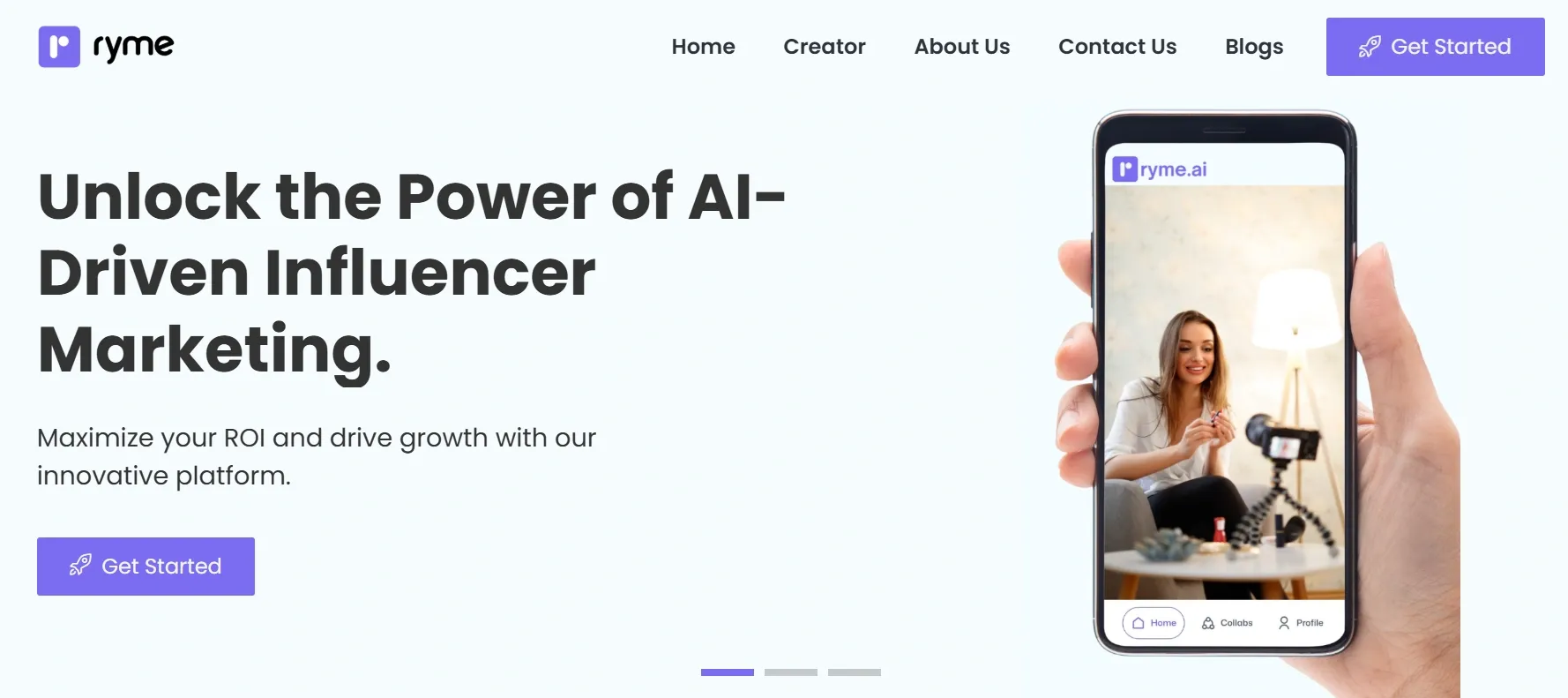
Key Features:
- Zero-commission model with no minimum budget requirements: This is a HUGE plus, especially for small to medium-sized D2C brands. You don't have to worry about hefty platform fees eating into your campaign budget, and you can start with whatever amount you're comfortable with. Want to run a campaign for ₹5,000 or ₹50,000? ryme.ai supports that.
- AI-driven influencer matching for precise collaborations: ryme.ai uses smart AI to connect you with influencers whose audience and content style genuinely align with your brand. This means more authentic partnerships and better results. No more endless scrolling hoping to find "the one"!
- Real-time performance analytics leveraging Meta API insights: Get up-to-the-minute data on how your campaigns are doing. Because ryme.ai taps into Meta API insights, you're getting accurate information directly from the source for your Instagram campaigns. This helps you see what’s working and make quick adjustments if needed.
- Streamlined content approval workflows to enhance efficiency: Say goodbye to confusing email chains and lost feedback. ryme.ai provides a clear, simple process for influencers to submit content and for you to review and approve it. This makes the whole collaboration smoother and faster.
Ideal For:
- Small to medium-sized D2C brands: If you're a D2C brand looking for an affordable and efficient way to get started with or scale your Instagram influencer marketing, ryme.ai is tailor-made for you. The zero-commission and no minimum budget are game-changers.
- Marketing teams at established brands: Even if you're part of a larger company, ryme.ai can offer a nimble and focused solution for your Instagram campaigns, potentially complementing other broader tools you might use.
- Growth marketers: If your goal is rapid growth and you need to experiment with different influencers and campaigns quickly and cost-effectively, ryme.ai's flexibility is a major advantage.
- Performance marketing managers: The focus on real-time analytics and Meta API insights means you can closely track performance and optimize for ROI, which is music to a performance marketer's ears.
Pain Points Addressed:
- High costs and tight budgets: Many influencer platforms come with significant subscription fees or commissions. ryme.ai's zero-commission model and no minimum budget directly tackle this, making influencer marketing accessible even if your budget is ₹X,XXX or ₹XX,XXX rather than lakhs.
- Difficulty in finding the right influencers: Sifting through millions of profiles is overwhelming. ryme.ai’s AI does the heavy lifting, matching you with relevant influencers, saving you time and ensuring a better fit. This is crucial because 61% of consumers prefer relatable influencers (Influencer Marketing Hub).
- Lack of actionable insights: Generic data isn't helpful. ryme.ai provides real-time, specific analytics from the Meta API, giving you clear insights into what's actually driving results for your Instagram campaigns.
- Content approval delays: The back-and-forth of approving content can be a bottleneck. ryme.ai’s streamlined workflow helps speed this up, getting your campaigns live faster.
Let's paint a picture: Imagine you're "Rohan's Roasted Coffee," a D2C brand selling artisanal coffee beans online. Your budget for influencer marketing is initially modest, say ₹20,000 per month.
Before ryme.ai: Rohan might be spending hours manually searching Instagram for food bloggers or lifestyle influencers, sending DMs that get lost, and struggling to track if the free coffee samples he sent out are actually leading to any posts or sales. He's worried about spending too much on an influencer who isn't a good fit.
With ryme.ai:
- Rohan signs up (no hefty upfront fee!).
- He uses the AI discovery to find 3 micro-influencers in India who focus on morning routines, coffee, and have an engaged audience of 25-45 year olds. The AI helps him see their authentic engagement rates and audience demographics.
- He sets up a campaign within his ₹20,000 budget, perhaps offering a mix of payment and free product.
- The influencers submit their proposed Instagram posts and Reels through ryme.ai's workflow. Rohan easily provides feedback (e.g., "Could you show the beans being ground in the Reel?").
Once live, Rohan tracks the likes, comments, shares, and importantly, clicks to his website (using unique discount codes he provided) directly in his ryme.ai dashboard. He sees that Influencer Priya's Reel showing her making a delicious brew with his beans and offering "PRIYA15COFFEE" for 15% off drove 50 sales in the first week! 🎉
ryme.ai helps Rohan avoid wasting money, find the right voices for his brand, and see a clear return on his efforts, all without the usual headaches. This focus on affordability and effectiveness makes it a strong contender.
2) Sprout Social Influencer Marketing (formerly Tagger)
Overview: Sprout Social is a well-known name in social media management, and their influencer marketing platform (which incorporates Tagger, a platform they acquired) is a comprehensive solution. It aims to cover the entire influencer marketing lifecycle.
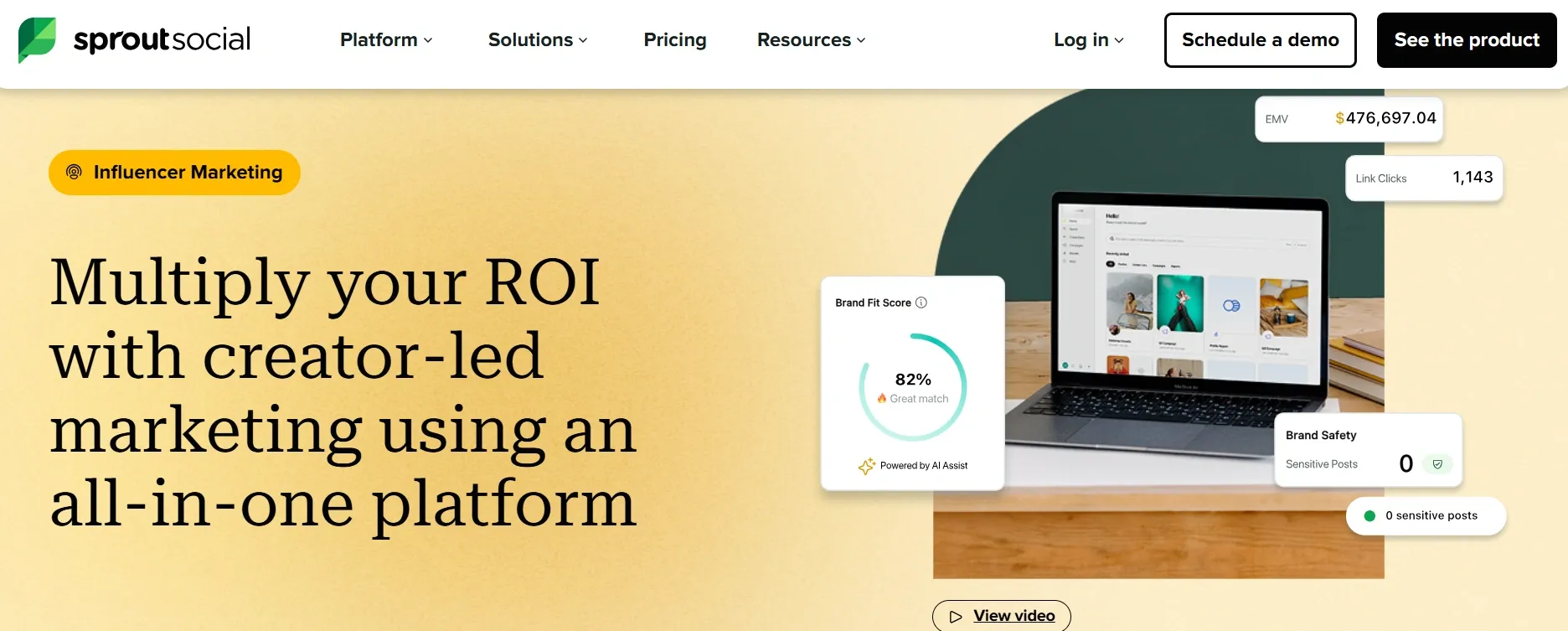
Key Features:
- AI-powered influencer search tools: Similar to ryme.ai, Sprout Social uses AI to help you find suitable influencers based on various criteria, including content analysis (semantic search) to ensure topical relevance.
- In-depth campaign performance insights: They offer robust analytics to track how your campaigns are performing, helping you measure ROI and understand what's resonating with audiences.
- Integration with social media management tools: A big plus if you're already using Sprout Social for your organic and paid social media, as it allows for a more integrated approach to your overall social strategy.
- Creator CRM: Helps you manage your relationships with influencers, keeping track of communications and past collaborations.
- Brand Safety Tools: Allows you to vet creators by looking at their past content and customize filters for risky topics like profanity or competitor mentions.
Ideal For: Brands seeking a holistic approach to influencer marketing, especially those already invested in or looking for a comprehensive social media management suite. If you want your influencer marketing, social listening, publishing, and analytics all under one roof (potentially), Sprout Social is a strong option.
Points to Consider: Being a comprehensive platform, its pricing might be more suited for medium to larger businesses that can leverage its full suite of features. Smaller D2C brands with very tight budgets might need to evaluate if they need all the functionalities offered.
Example: A larger retail brand like "UrbanStyle India" could use Sprout Social. They manage multiple social media accounts, run paid ad campaigns, and have a dedicated marketing team.
- Their team uses Sprout's AI to discover fashion and lifestyle, macro and micro-influencers for their new summer collection launch. They use brand safety tools to ensure influencer content aligns with their family-friendly image.
- Campaigns are managed within the platform, from outreach to content approval.
The performance of influencer posts is tracked alongside their organic social media metrics and paid ad performance, all within Sprout, giving them a unified view of their social ROI. For instance, they can see how an influencer's post about a new dress drives engagement and compare it to the performance of their own branded content for the same item.
Sprout Social offers a powerful, integrated solution for brands that want deep functionality across their social media efforts.
3) Influencity
Overview: Influencity is a platform that prides itself on connecting brands with a massive network of content creators—they mention over 200 million! It’s designed to streamline the entire influencer marketing process from discovery to reporting.
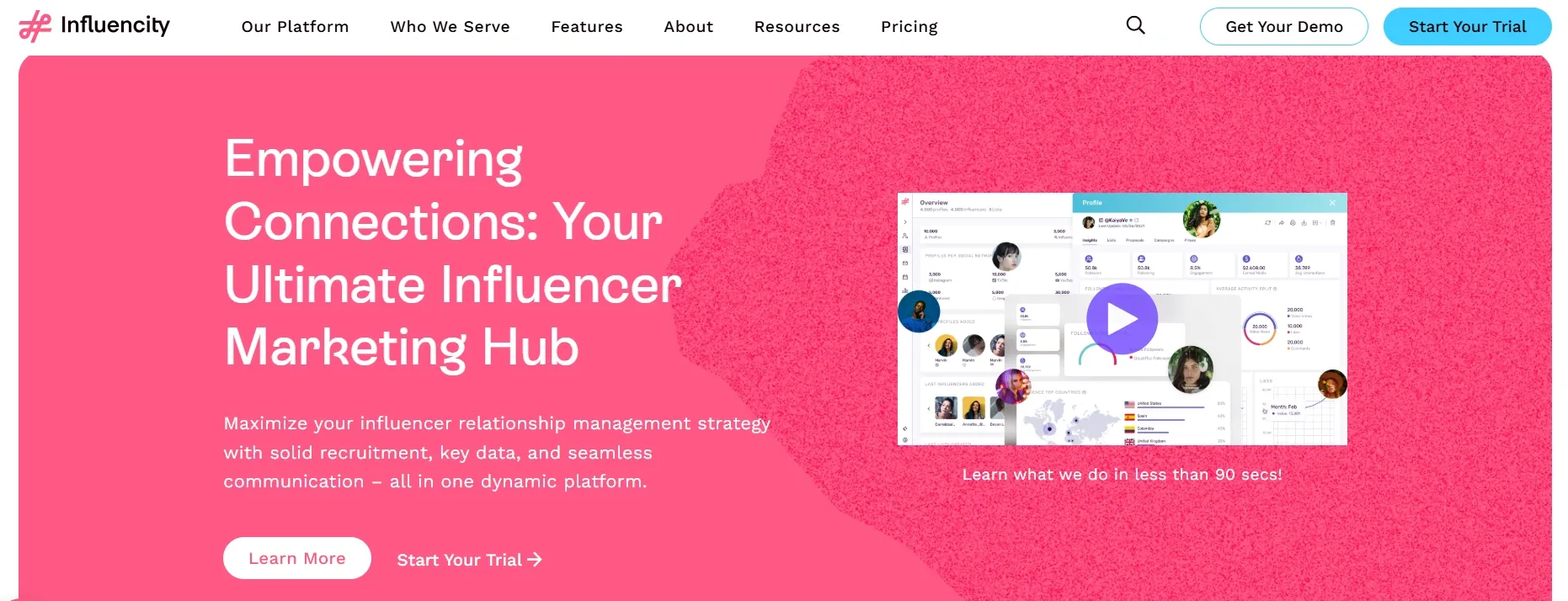
Key Features:
- User-friendly dashboard for campaign management: They focus on making it easy to manage all aspects of your campaigns in one place.
- Access to a vast network of influencers: If sheer numbers and global reach are important, Influencity offers a very large pool to search from. They provide on-demand insights on public profiles globally.
- Influencer Relationship Management (IRM): Tools to organize your influencer database, track negotiations, and save price histories.
- Shopify Integration: This is great for e-commerce brands, allowing for influencer seeding campaigns by integrating with your Shopify store. Influencers can then order and receive gifted products like regular customers.
- Ideal For: Brands aiming to scale their influencer marketing efforts significantly and those who need to tap into a very large and diverse global database of influencers. Agencies managing multiple client campaigns could also find its organizational features useful.
Example: "GlobalGadget Corp," an electronics company launching a new product in multiple countries, could use Influencity.
- They need to find tech influencers in North America, Europe, and Southeast Asia. Influencity's large database helps them identify potential partners in each region.
- They use the IRM to manage communications and contracts with dozens of influencers simultaneously.
- If they are seeding products, the Shopify integration (if applicable) could streamline sending review units.
- They track campaign performance across different regions to see which markets and influencers are delivering the best results for their new gadget.
- Influencity is a strong choice for brands with ambitious, large-scale influencer marketing plans.
4) Shopify Collabs
Overview: As the name suggests, Shopify Collabs is an influencer marketing platform built specifically for businesses that use Shopify to power their e-commerce stores. It's all about seamless integration.
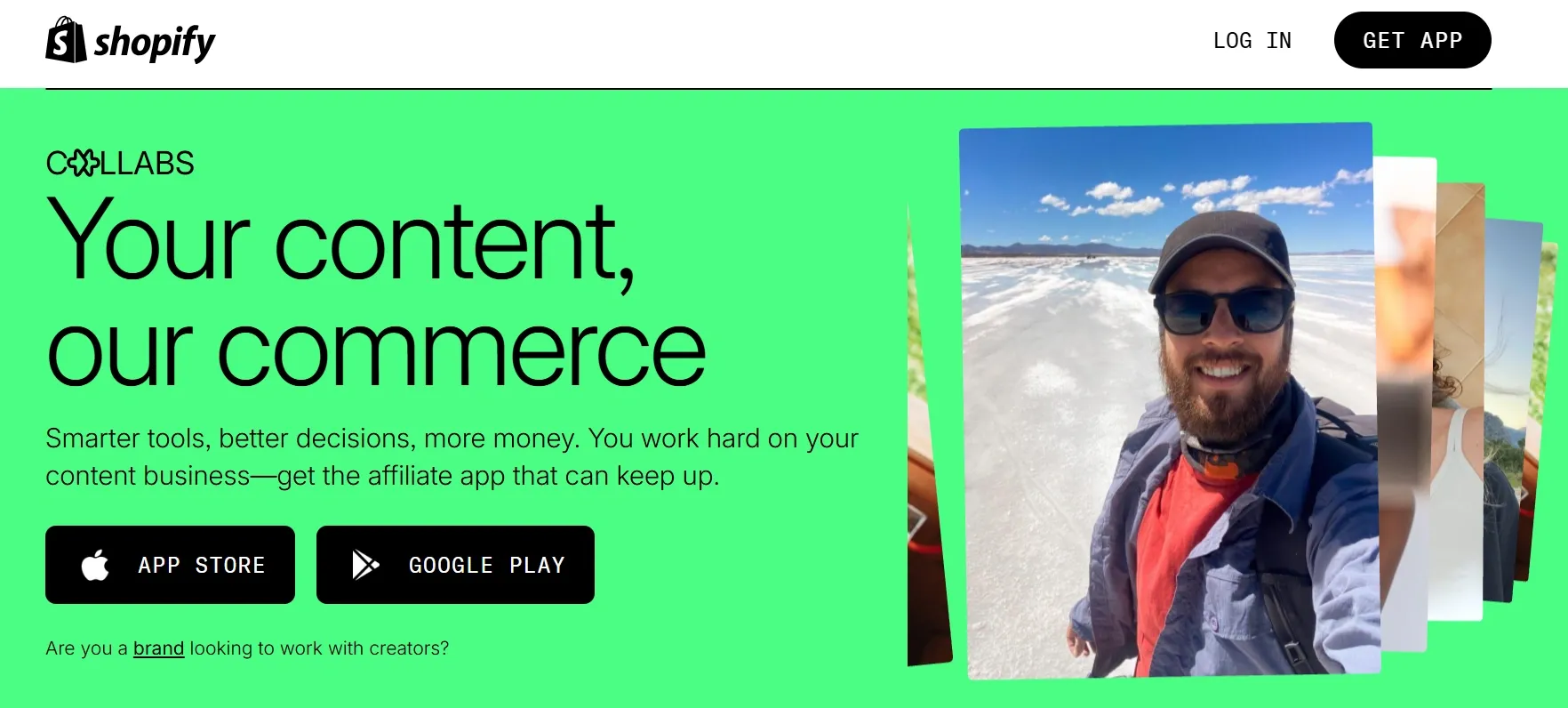
Key Features:
- Seamless integration with Shopify stores: This is its core strength. You can manage collaborations, track affiliate sales generated by influencers, and even handle payments (though payments are often limited to PayPal) directly within your Shopify ecosystem.
- Creator Marketplace: Shopify curates a database of creators across various niches, making it easier for merchants to find potential partners. You can filter by audience size, channel, etc.
- Affiliate Sales Tracking: Easily create unique links and discount codes for your influencers and track the sales they drive. Commissions can be calculated automatically.
- Ideal For: E-commerce brands using Shopify as their platform. If your store runs on Shopify, this app is designed to make your life much easier by keeping everything connected. This is perfect for driving sales and managing affiliate relationships.
Example: "DesiDecor," a Shopify store selling Indian home decor items.
- The owner uses Shopify Collabs to browse the creator marketplace and finds several home decor influencers whose style matches their brand.
- They invite these influencers to collaborate, offering them a commission on sales they generate through a unique discount code (e.g., "DECORSTYLE10").
- When an influencer posts about a beautiful "DesiDecor" cushion cover with their code, customers who use the code get a discount, and the sale is automatically tracked in Shopify Collabs. The store owner can easily see which influencers are driving the most revenue.
- Payments to affiliates can be managed through the platform.
- If you're on Shopify, Shopify Collabs is a no-brainer to explore for its convenience and direct sales attribution capabilities.
5) SocialBook
Overview: SocialBook aims to be an all-in-one platform for both influencers and brands, connecting them across various social media platforms like YouTube, Instagram, and TikTok. They also offer additional tools for content creation.
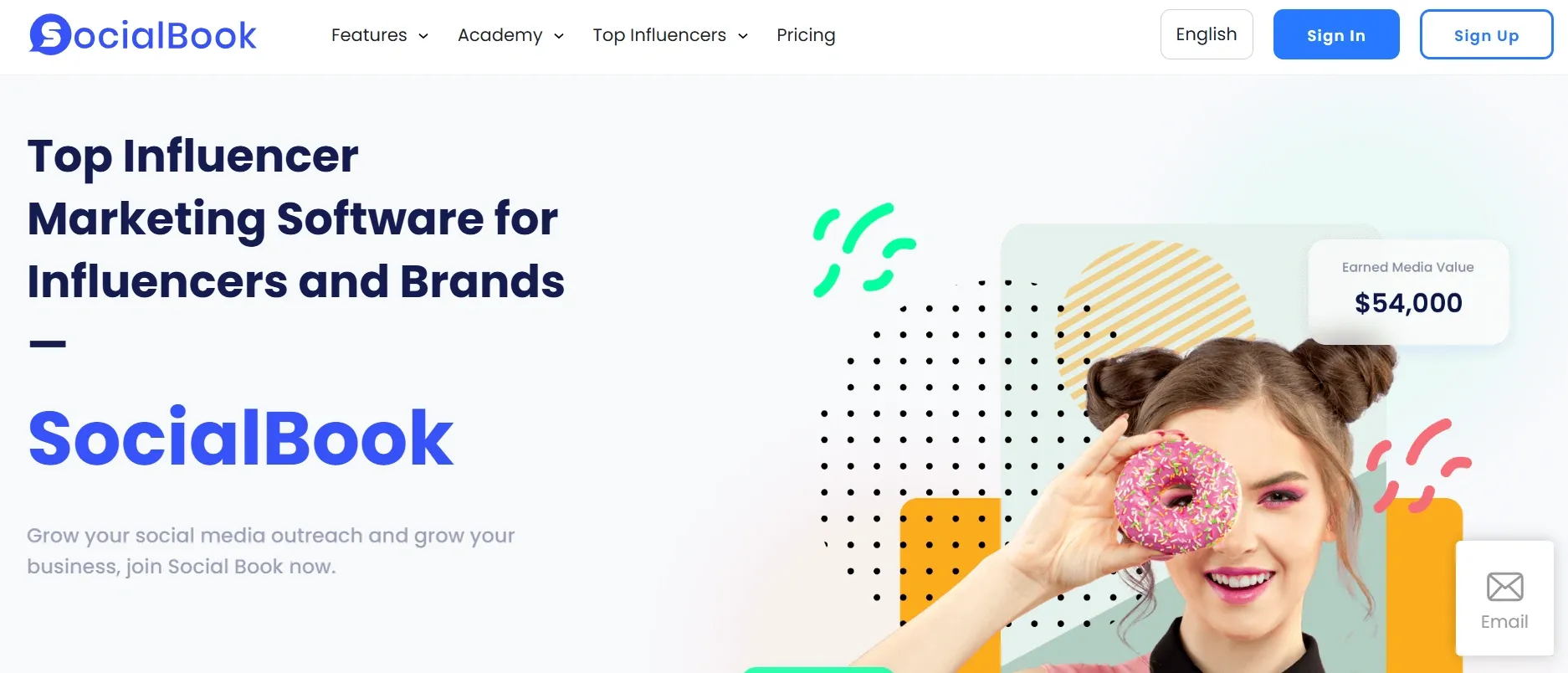
Key Features:
- Comprehensive analytics tools: Provides detailed statistics on influencer performance and audience demographics. They also help influencers gauge how much to charge.
- Campaign management features: Tools to help brands run and manage their influencer collaborations.
- Influencer-facing tools: SocialBook also offers features for influencers, such as photo/video editing tools and help with finding brand deals, which can make the platform attractive to creators.
- Ideal For: Brands seeking detailed insights into influencer performance across multiple platforms and those who appreciate a platform that also caters to the needs of creators (which can lead to a more engaged influencer-base on the platform).
Example: A mobile gaming company, "GameOn Studios," wants to promote its new game.
- They use SocialBook to find gaming influencers on YouTube and TikTok who have an audience matching their target player demographic.
- They use SocialBook's analytics to vet these influencers, looking at their viewership, engagement on past sponsored content, and audience authenticity.
- They run a campaign where influencers create gameplay videos and review the new game. SocialBook helps them manage these collaborations and track metrics like views, click-throughs to the game's download page, and comments.
SocialBook provides a suite of tools that can be valuable for brands wanting data-driven campaigns across popular video and image platforms.
6) IndaHash
Overview: IndaHash is an international influencer marketing platform that focuses on connecting brands with influencers around the world. They emphasize their global reach and a vetting process for their creators.
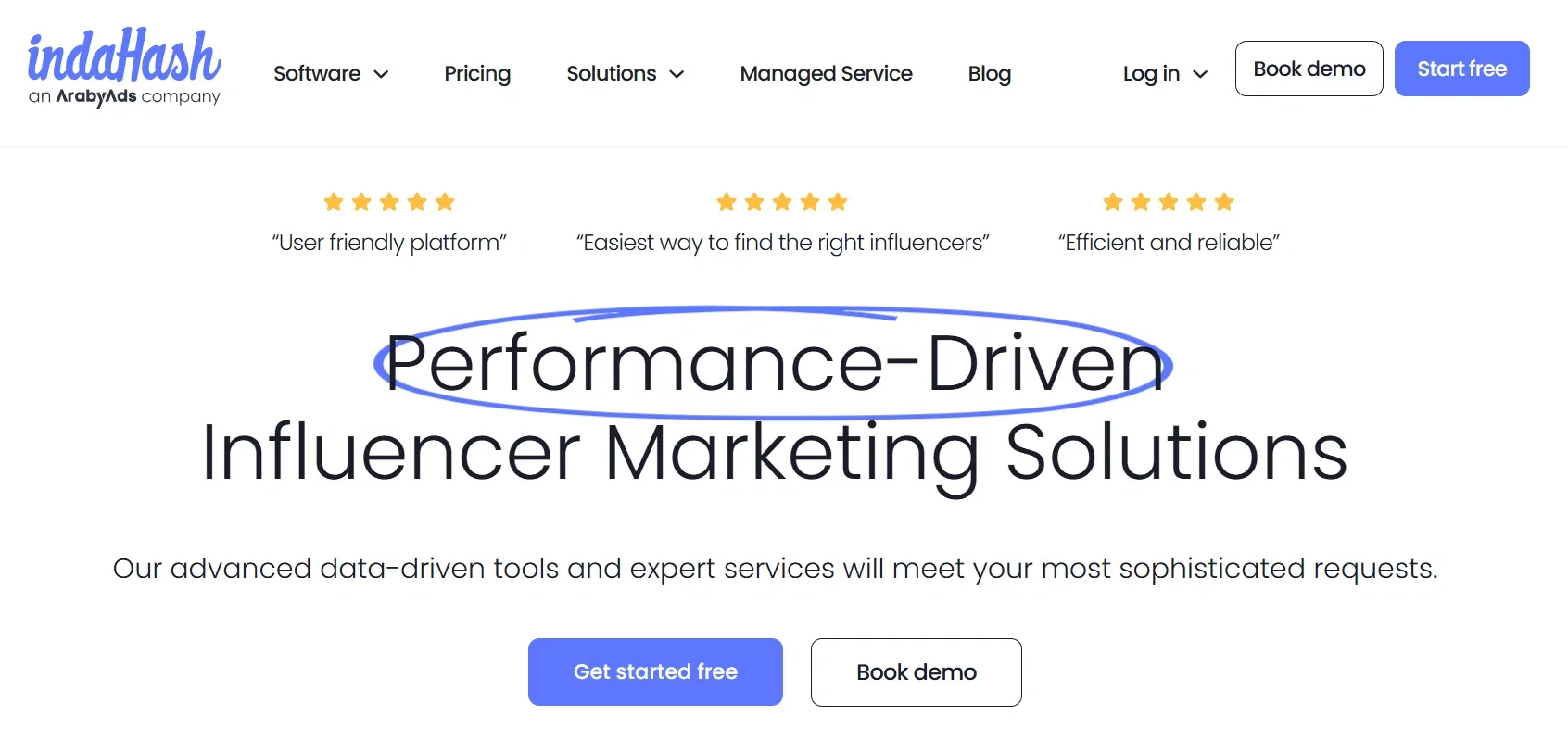
Key Features:
- Global reach across multiple social media platforms: If you're a brand looking to run campaigns in different countries, IndaHash offers access to a geographically diverse network of influencers. They were recognized by Influencer Marketing Hub in 2025.
- Vetting process for influencers: They have a system for checking influencers, which can provide an added layer of quality control for brands.
- Managed and Self-Service Options: They offer different ways to engage with their platform, from fully managed campaigns run by their team to self-service dashboards for brands that prefer to handle things themselves.
- Focus on technology: IndaHash highlights their commitment to technology with features like sentiment AI and ROI tracking.
- Ideal For: Brands looking to expand their reach internationally and run campaigns in multiple markets. Companies that appreciate a platform with a global footprint and different service models will find IndaHash appealing.
Example: "TasteGlobal Snacks," a food brand launching a new line of exotic chips in five different European countries.
- They use IndaHash to find food influencers in each target country (e.g., France, Germany, Spain, Italy, UK).
- They might opt for IndaHash's managed services to help coordinate the campaign across these different markets and languages.
- The campaign involves influencers creating unique recipes or taste-test videos featuring the new chips, tailored to local preferences. IndaHash helps manage the logistics and track the overall performance across all five countries.
- IndaHash is a solid choice for brands with global ambitions for their influencer marketing.
7) Kofluence
Overview: Kofluence is a platform designed to enable seamless, direct connections between brands and influencers, cutting out the middleman. It began as a mobile-first app, often compared to "Tinder for collabs," simplifying the influencer marketing process and making it more approachable for brands of all sizes.
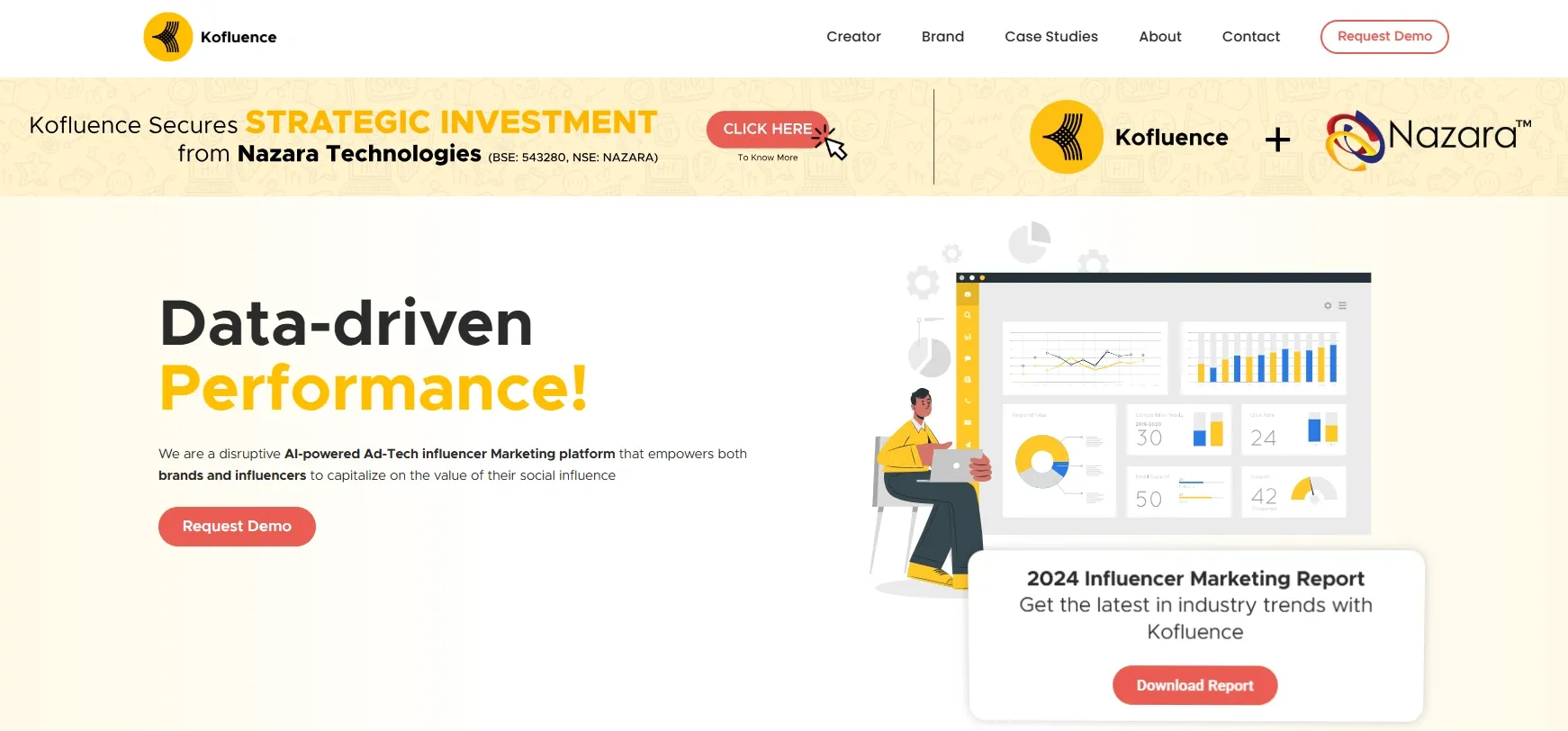
Key Features:
- Direct Communication Tools: Once a match is made (both brand and influencer agree to collaborate), they can chat directly within the app, making the negotiation process quick and easy.
- Campaign Management: Features allow users to set posting schedules, define pay rates, and securely handle payments, which are held in escrow until tasks are verified.
- Inclusive Approach: Kofluence is open to influencers and brands of all sizes. It believes that everyone has influence and provides comprehensive filters to help brands find the perfect match for their campaign needs.
- Free to Join: Kofluence offers free access to the platform, with optional paid memberships for those who need additional features like unlimited collaborations or brand-to-brand partnerships.
Ideal For:
Brands, particularly smaller businesses or those new to influencer marketing, looking for a more hands-on, direct approach to collaborating with influencers. Kofluence provides a personalized experience that connects you with the right influencers for your needs.
Example:
"EcoChic Boutique," a small online store selling handmade, eco-friendly jewelry with a campaign budget of ₹10,000 - ₹15,000, creates a profile on Kofluence. The owner wants to collaborate with micro-influencers who are passionate about sustainability and ethical fashion.
Using Kofluence’s filtering tools, they find influencers with the right audience and follower count. After sending collaboration requests, the influencers who accept are able to chat directly in the app about content details (e.g., Instagram posts featuring the jewelry), posting dates, and compensation (a combination of products and a small fee, such as ₹3,000 - ₹5,000 per influencer).
The payment process is securely managed via Kofluence’s escrow system, ensuring everything is handled smoothly.
Kofluence is perfect for brands that want to build genuine, direct relationships with influencers and value a platform that's easy to use and accessible to all influencers.
8) Ainfluencer
Overview: Ainfluencer is an Instagram-focused platform (also supporting TikTok and YouTube) that aims to connect brands with influencers, with a notable feature being that it's "100% Free" for many of its core functionalities.
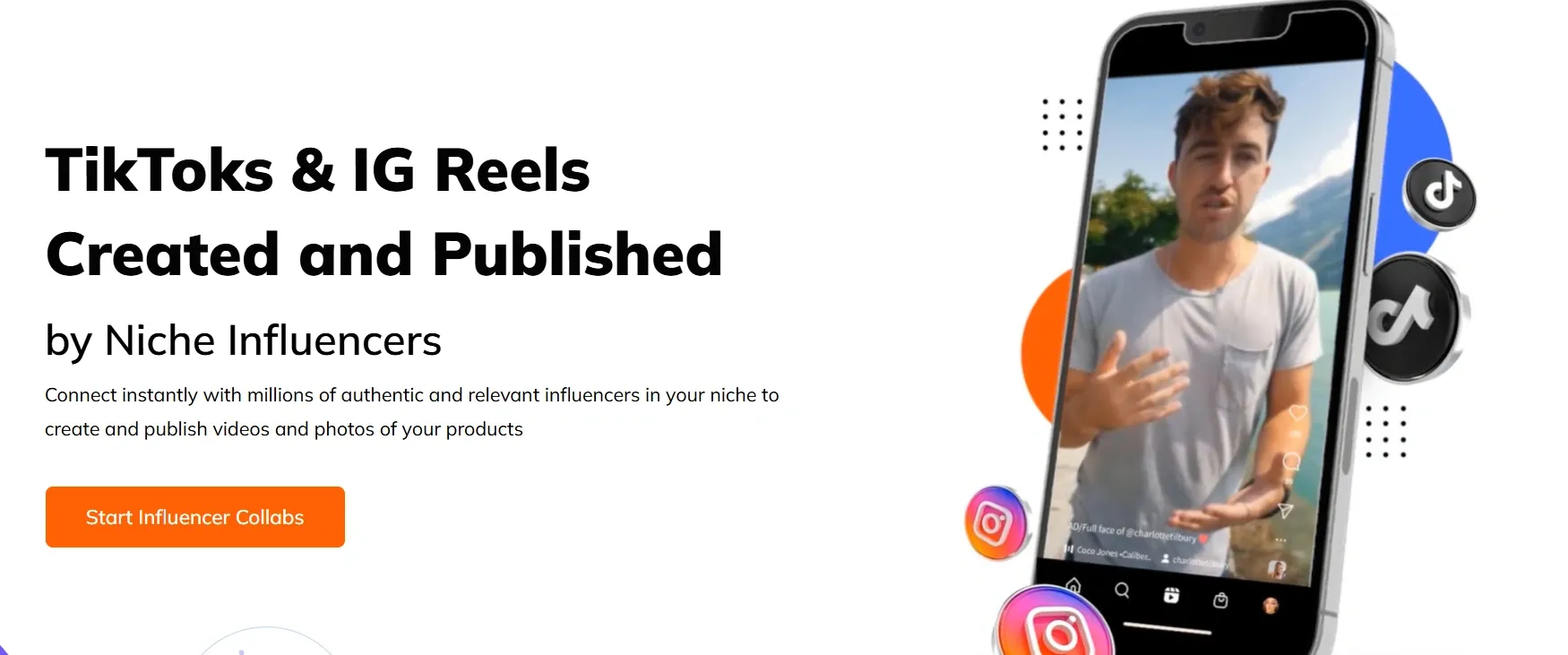
Key Features:
- AI-Powered Discovery & Automated collaboration processes: Helps brands find relevant influencers and streamlines parts of the collaboration process.
- Free to Use (Core Features): Brands can create campaigns, find influencers using AI, invite them, and negotiate deals without platform fees for these basic actions.
- Secure Escrow Payments: Ensures funds are only released when content is delivered as agreed.
- Direct Communication: Allows brands and influencers to negotiate terms without middlemen.
- Ideal For: Brands, particularly small businesses and startups, that are primarily focused on Instagram (and increasingly TikTok/YouTube) and are looking for a cost-effective way to get started with influencer discovery and outreach. The free model is very attractive for those on tight budgets.
Things to note from reviews: Some users have mentioned that response rates from influencers can vary, and finding active influencers might take time. This is a common challenge on many platforms, especially free ones, but something to be aware of.
Example: "PetPals Pantry," a local D2C brand selling organic pet food, wants to increase awareness among pet owners in their city. Their budget is around ₹8,000 for their first campaign.
- They sign up for Ainfluencer (for free!).
- They create a campaign looking for Instagram micro-influencers in their city who are pet owners and post frequently about their pets.
- Ainfluencer's AI suggests some potential matches. The brand sends out invitations.
- They connect with a couple of local pet influencers, negotiate a deal (perhaps free product plus a small fee of ₹2,000-₹3,000 each), and the influencers post cute pictures of their pets enjoying the PetPals Pantry food.
- Transactions are handled via the escrow system.
- Ainfluencer offers a very low barrier to entry for brands wanting to dip their toes into influencer marketing, especially on Instagram.
9) IZEA
Overview: IZEA is one of the veterans in the influencer marketing space, offering a range of solutions for various social media platforms. They work with a wide spectrum of influencers, from nano to celebrities, and cater to large brands, including Fortune 50 companies.

Key Features:
- Influencer discovery tools: Access to a diverse network of creators.
- Campaign management features: End-to-end management, from contracts and licensing to content review.
- Focus on Paid Media Amplification: IZEA emphasizes backing influencer content with targeted paid media to extend reach beyond organic, using data from sources like IRI and Nielsen Catalina for targeting.
- Content Rights Management: They handle contracts and usage rights, allowing brands to repurpose influencer content in other marketing efforts.
- Managed Services: For brands that want more hands-on support, IZEA offers expert strategy and campaign execution.
- Ideal For: Brands, particularly larger ones, seeking a comprehensive influencer marketing solution that can include sophisticated paid media amplification and detailed content rights management. If you're looking for a full-service approach or need to ensure you can broadly use influencer content, IZEA is a strong contender.
Example: A national beverage company, "FreshSip Juices," is launching a new line of healthy drinks.
- They partner with IZEA for a large-scale campaign involving lifestyle, health, and wellness influencers across India.
- IZEA helps them identify influencers, negotiate contracts (including rights to use influencer photos in digital ads and in-store displays), and manage the campaign.
- Influencer posts are created and go live. IZEA then uses paid media to boost the top-performing content to a wider, highly targeted audience based on shopper data. This ensures the campaign reaches not just the influencers' followers but also other potential customers who fit the ideal consumer profile for FreshSip Juices.
- The brand can then repurpose the best influencer images for their website and social media ads, having secured the rights through IZEA.
- IZEA is well-suited for established brands that require robust campaign management and want to maximize reach through paid promotion.
10) CreatorIQ
Overview: CreatorIQ is an enterprise-level influencer marketing platform designed for large companies with complex needs. It focuses on data-driven insights and scaling global creator programs.
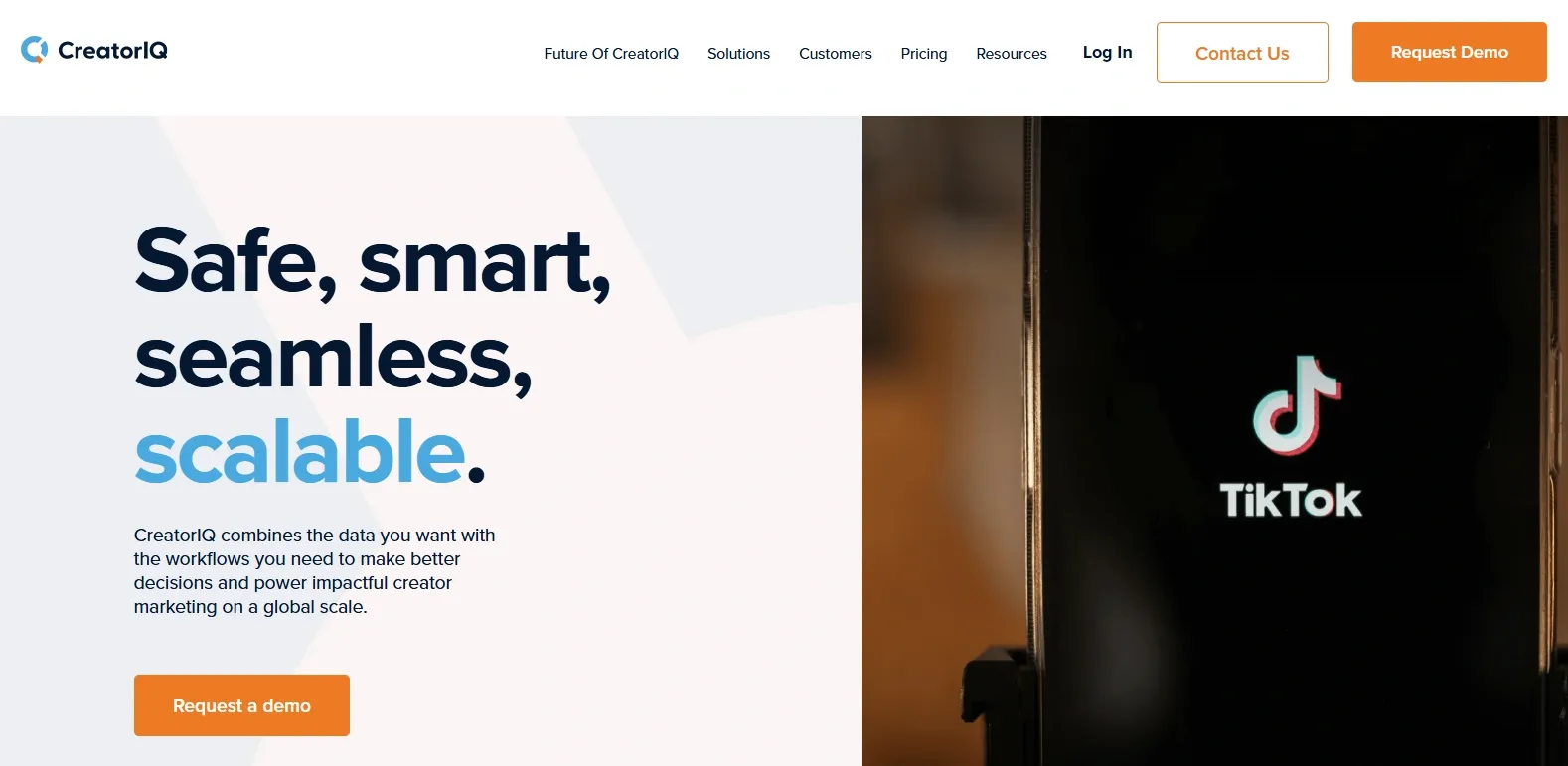
Key Features:
- Advanced analytics tools: Deep data analysis, directly integrating with social media APIs to analyze over a billion public social accounts.
- Influencer CRM: Robust tools for managing relationships with a large number of creators.
- AI-powered Discovery & Vetting: Sophisticated AI for finding and evaluating influencers at scale, including analyzing past content for brand safety and fit.
- Integration with various marketing tools: Offers extensive API integrations for seamless workflows with other enterprise systems.
- Global Scalability: Supports multi-language campaigns and diverse market strategies. They are also part of YouTube's Measurement Program (YTMP).
- Ideal For: Large enterprises with complex, often global, influencer marketing needs. If you're managing hundreds or thousands of influencer relationships, require deep integrations with your existing marketing tech stack, and need very granular analytics and control, CreatorIQ is built for you.
Example: A global tech giant, "Innovate Corp," runs ongoing influencer programs across multiple product lines and regions.
- They use CreatorIQ to manage their entire global network of tech reviewers, lifestyle influencers, and brand ambassadors.
- Their marketing teams in different countries can access the platform to find local influencers, run regional campaigns, and track results, all while maintaining global brand consistency.
- CreatorIQ's AI helps them identify rising stars in emerging tech fields and vet them thoroughly. Advanced analytics provide detailed reports on ROI for multi-million dollar influencer marketing budgets.
- The platform integrates with their CRM, BI tools, and other marketing software, providing a centralized command center for their entire creator ecosystem.
- CreatorIQ is the powerhouse for large organizations that view influencer marketing as a core, scalable part of their global strategy.
Whew! That's a lot of great options, right? Each platform has its strengths and is geared towards different types of brands and needs. The key is to think about your specific goals, budget, and the scale of your influencer marketing ambitions.
Conclusion
Choosing the right influencer app is crucial for brand growth. It involves finding the right influencer, managing campaigns efficiently, and tracking results. India's growing influencer market offers immense opportunities, but effective tools are necessary. Key criteria include AI-powered discovery, campaign management, budget flexibility, and analytics.
Platforms like ryme.ai and CreatorIQ offer different advantages based on brand needs. AI is vital for selection, and measurable results and authentic content are key trends. Try demos to find the best tech partner for your influencer marketing efforts.
